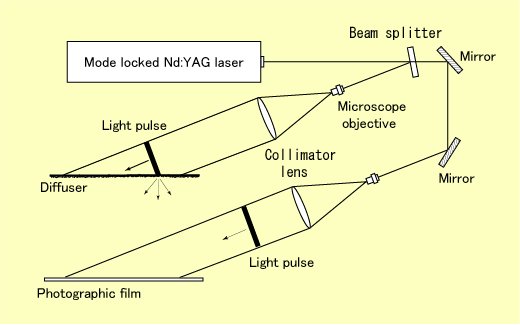
Top page
We demonstrate the propagation of a light pulse undergoing refraction and total refraction inside a glass block, as well as diffraction at a grating.The visualization of a frameless, continuous motion picture of the light propagation is possible by recording a hologram using a ultrashort pulsed laser. It is shown that the direction of the pulse changes due to refraction and its speed decreases inside a glass block and the pulse travels in a zigzag way by total reflection. The pulse fronts of the diffracted light propagation parallel to the grating surface are also demonstrated.
Laser development has made it possible to easily obtain an ultrashort light pulse in the order of pico and femtoseconds. A light pulse of 3.3 picoseconds has a length of only 1mm and propagates at a speed of 300,000km per second. Of course, it cannot be directly seen. Moreover, unlike ordinary continuous light signals, interference between two such short pulses occurs only when they arrive at a point simultaneously. Recording such interference as a hologram makes it possible to visualize the propagation of the light, which is analogous to the propagation of a ring of waves on water. Here we demonstrate for the first time the propagation of a light pulse undergoing refraction and total reflection inside a medium, as well as diffraction by a grating, which are well known phenomena in physics and the formulae have been established.
. A hologram is a photographic record of interference pattern produced by the light waves scattered from an object and a reference wave. When an identical reference beam is used to illuminate the hologram, the original scattered waves are reproduced, resulting in a three dimensional image of the object. This technique of recording and reproducing a wavefront is known as holography. To record a hologram, the light from a laser is divided into two beams. One is used to illuminate the object and the other acts as the reference.
When a continuously emitted laser beam is used to record a hologram, the image can be reproduced from any position on it because the object wave spreads over the entire hologram and interferes with the reference wave at any point. On the other hand, when an ultrashort light
pulse is used, interference on the photographic plate occurs only where the
pulse from the object and the pulse from the reference wave arrive at the same
time. If the pulse from the reference
wave is incident to the plate at an oblique angle, its arrival time varies from
point to point on the hologram. This
makes it possible to obtain a time resolved recording of the object wave along
the transverse axis of the hologram.
This is called a glight-in-flighth recording and is used as a time-gated
viewing system for ultrafast phenomena. When the hologram is illuminated with
continuous light wave, each different portion of the hologram reconstructs the
image at a different time. Therefore, it
is possible to observe a frameless, continuous motion picture of the light
propagation by moving the point of observation along the hologram, as if one
were riding along the light waves.

In light-in-flight recording, a diffusely reflecting surface is illuminated by the light pulse at an oblique angle. The scattered wave from the surface is used as the object wave. In our experiments on refraction and internal reflection, a ground glass plate set in close contact to a glass block. The observation of the light propagation inside the glass block is possible when the side of the glass block facing to the ground glass plate is a diffusing surface. A collimated reference wave is incident on the photographic plate at an oblique angle and interferes with the scattered wave from the diffuse surface.
The light source used for the experiments was a mode-locked Nd:YAG laser with a repetition rate of 82MHz operated at 532nm(Spectra-Physics Model 3800S). The duration of the light pulse was about 10ps. A Konica P-5600 holographic plate was used to record the hologram.
Propagation of light through a cylindrical lens
The following picture shows the light through a cylindrical lens. Once the light is focuses after the light through the lens and then is diverged. The light outside the lens proceeds as it is. We usually observe such picture when a continuously emitted light is used.
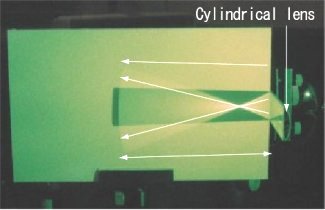
On the other hand, we can see the time sequence of light propagation through
the lens by recording the hologram with ultrashort pulsed laser. The display
for animation (88KB) is.....
| click here |
The light passed by a light bulb
The following pictures are the reconstructed images of light pulses passing
through the light bulb. You can see the situation of light propagation
passing by the light bulb when you look through the hologram and your eye
moves laterally.


The hologram was recorded by the following optical arrangement. The laser
located at the bottom of the flat table is Nd:YAG laser.
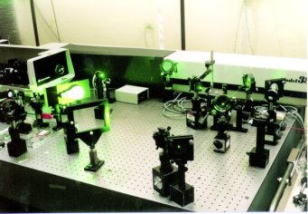
Refraction of light
Next, we demonstrate the propagation of light passing through a glass block. We usually see the following picture which shows the refraction of light by the glass block. The light is incident to the glass block from upper right. At a boundary between the block and air, the light splits into two parts: a refracted light which proceeds into the block and a reflected light which propagates back into the air. The direction of the former is determined by law of refraction(Snellfs law)
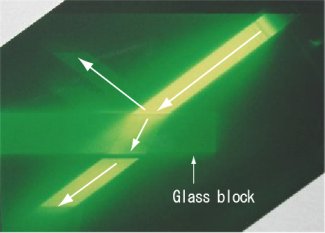
How can this be seen when the hologram is recorded with ultrashort pulsed laser? @The display for animation (206KB) is.....
| click here |
The root of IT is the optical communication which used an optical fiber. There, information is put on the pulse light and is sent superspeed. You who are seeing this home page now by the Internet, too, are favored with this beneficence. Light propagates inside the optical fiber by total reflection.
The following picture shows the total reflection of light inside the glass
block. The light enters the glass block from the lower right and travels in a zigzag way inside
the glass block by total reflection.
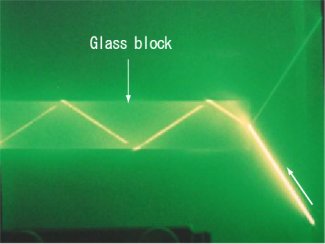
How can this be seen when the hologram is recorded with ultrashort pulsed laser? @The display for animation (90KB) is.....
| click here |
Diffraction by a diffraction grating
Diffraction grating is used for separation of light into spectral components.
When a monochromatic light, such as laser light, enters the diffraction
grating, the light is diffracted in several directions as shown in the
following picture. The spatial frequency of the grating is 634 lines/mm and the first and second diffraction angles are }20.0 and }43.2, respectively, for 532nm light.
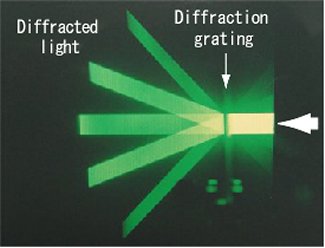
When the hologram is recorded with ultrashort pulsed laser, we can see the propagation of the diffracted lights. The display for animation (125KB) is.....
| click here |
T. Kubota and Y. Awatsuji:Observation of light propagation by holography
with a picosecond pulsed laser, Opt. Lett. 27,10,815-817(2002).